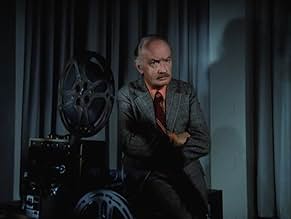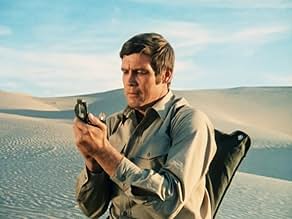IMDb RATING
6.9/10
5.3K
YOUR RATING
After an astronaut and test pilot is catastrophically mutilated in a test plane crash, he is rebuilt and equipped with nuclear powered bionic limbs and implants.After an astronaut and test pilot is catastrophically mutilated in a test plane crash, he is rebuilt and equipped with nuclear powered bionic limbs and implants.After an astronaut and test pilot is catastrophically mutilated in a test plane crash, he is rebuilt and equipped with nuclear powered bionic limbs and implants.
- Awards
- 1 nomination
Charles Robinson
- Prisoner
- (as Charles Knox Robinson)
George D. Wallace
- General
- (as George Wallace)
Olan Soule
- Saltillo
- (as Olan Soulé)
Claire Brennen
- OSI Committee Member
- (uncredited)
Eddie Garrett
- Security Guard outside Steve's room
- (uncredited)
Storyline
Did you know
- TriviaDuring the opening sequence of the show, the crash shown is actual footage of a crash of the M2-F2 experimental lifting body that was part of the research that eventually led to the development of the space shuttle.
- GoofsThe "Factual Error" that Austin's human left arm should have been amputated to prevent incompatible balance produces an enormous character error if such had occurred. The friendship that is demonstrated between Austin and Dr. Wells would never allow the latter to amputate a healthy arm of his friend, whether it would be mechanically efficient or not. Further, Dr. Wells is portrayed as the kind of man not to violate his Hippocratic oath of "Do no harm" which such an amputation would be in contrast to.
- Quotes
Dr. Rudy Wells: I want to show you something, Steve. This is your arm.
Steve Austin: That's it, huh?
Dr. Rudy Wells: Um-hmn. We're rather proud of it. There's a manual that goes with it that has eight hundred and forty pages. I'll give you a copy.
- Alternate versionsRe-edited into two episodes of "The Six Million Dollar Man" for syndication. To pad out the story, scenes were added from The Bionic Woman (1975), The Bionic Boy (1976) and Dark Side of the Moon: Part 1 (1977).
- ConnectionsEdited from Lost Flight (1970)
Featured review
The TV movie that led to "The Six Million Dollar Man" becoming one of the biggest hits of the 1970s, and being fondly remembered by many who were the right age at the time (not least me - I still remember playing with my Steve Austin doll), is strikingly different from what would come. Admittedly the series was hardly a laugh riot, but the source was even straighter, with nothing to indicate that Col. Austin would eventually acquire a bionic girlfriend (and dog) and meet the likes of Bigfoot, a double, and alien killer machines. (We won't mention that "Sweet Jaime" song.)
Not only does Henri Simoun's teleplay furnish our hero with some actual doubt over how much of a human being he is now, but the relationship between him and his superior officer is less chummy - no benevolent Oscar Goldman of the OSI here, instead the OSO's colder Spencer (Darren McGavin, easily taking the acting honours). Plus, when Steve is eventually sent into the field, it's surprisingly straightforward - the movie emphasises drama over derring-do (note the lack of DANANANANANANA sound effects). This isn't always for the best; the actual crash isn't as effective as it could have been, and 30 years on some elements have dated somewhat - who'd be so casual about a nuclear-powered motor today? - but if ultimately it's not as much fun as the series, it's also a bit more thoughtful.
Footnotes: This movie was edited into two parts and shown on the series as "The Moon And The Desert." More importantly, no one here calls him "a man barely alive," let alone says "We can rebuild him" or "We have the technology."
Not only does Henri Simoun's teleplay furnish our hero with some actual doubt over how much of a human being he is now, but the relationship between him and his superior officer is less chummy - no benevolent Oscar Goldman of the OSI here, instead the OSO's colder Spencer (Darren McGavin, easily taking the acting honours). Plus, when Steve is eventually sent into the field, it's surprisingly straightforward - the movie emphasises drama over derring-do (note the lack of DANANANANANANA sound effects). This isn't always for the best; the actual crash isn't as effective as it could have been, and 30 years on some elements have dated somewhat - who'd be so casual about a nuclear-powered motor today? - but if ultimately it's not as much fun as the series, it's also a bit more thoughtful.
Footnotes: This movie was edited into two parts and shown on the series as "The Moon And The Desert." More importantly, no one here calls him "a man barely alive," let alone says "We can rebuild him" or "We have the technology."
- Victor Field
- May 25, 2003
- Permalink
Details
- Release date
- Country of origin
- Language
- Also known as
- The Six Million Dollar Man: The Moon and the Desert
- Filming locations
- Production company
- See more company credits at IMDbPro
- Runtime1 hour 15 minutes
- Sound mix
- Aspect ratio
- 1.33 : 1
Contribute to this page
Suggest an edit or add missing content

Top Gap
By what name was The Six Million Dollar Man (1973) officially released in Canada in English?
Answer































